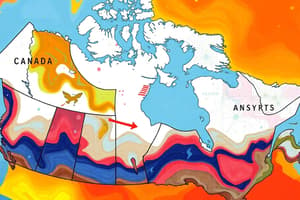Podcast
Questions and Answers
What is the largest ocean on the east coast of the United States?
What is the largest ocean on the east coast of the United States?
- Atlantic Ocean (correct)
- Arctic Ocean
- Pacific Ocean
- Bering Sea
Which ocean is located on the west coast of the United States?
Which ocean is located on the west coast of the United States?
- Atlantic Ocean
- Pacific Ocean (correct)
- Hudson Bay
- Gulf of Mexico
What is the name of the bay located in Canada connected to the Atlantic Ocean?
What is the name of the bay located in Canada connected to the Atlantic Ocean?
Hudson Bay
What river is known for flowing through the central United States?
What river is known for flowing through the central United States?
Which mountain range extends along the western part of the United States?
Which mountain range extends along the western part of the United States?
What city is the capital of the United States?
What city is the capital of the United States?
Which city is known as the largest city in Canada?
Which city is known as the largest city in Canada?
Which ocean borders Canada to the north?
Which ocean borders Canada to the north?
The ______ is a major river that forms part of the United States-Mexico border.
The ______ is a major river that forms part of the United States-Mexico border.
Which region of the United States does not include Alaska and Hawaii?
Which region of the United States does not include Alaska and Hawaii?
Flashcards
Pacific Ocean
Pacific Ocean
The largest ocean, located west of the United States.
Arctic Ocean
Arctic Ocean
The smallest and shallowest ocean, located north of the United States and Canada.
Lake Superior
Lake Superior
The largest freshwater lake in North America.
St. Lawrence River
St. Lawrence River
Signup and view all the flashcards
Rocky Mountains
Rocky Mountains
Signup and view all the flashcards
Appalachian Mountains
Appalachian Mountains
Signup and view all the flashcards
Rocky Mountains Region
Rocky Mountains Region
Signup and view all the flashcards
Pacific Region
Pacific Region
Signup and view all the flashcards
Prairies
Prairies
Signup and view all the flashcards
Central Canada
Central Canada
Signup and view all the flashcards
Study Notes
Oceans
- Atlantic Ocean: Located to the east of the United States and Canada.
- Pacific Ocean: The largest ocean, situated to the west of the United States; includes coastal states.
- Arctic Ocean: The smallest and shallowest ocean, located north of both countries.
- Bering Sea: Located between Alaska and Russia, part of the North Pacific Ocean.
- Hudson Bay: A large body of water in northeastern Canada, connected to the Atlantic Ocean.
- Gulf of Mexico: A sea to the southeast of the United States, bordered by states like Texas and Florida.
Great Lakes
- Lake Superior: The largest freshwater lake in North America, located at the upper left.
- Lake Michigan: The only Great Lake located entirely within the United States.
- Lake Huron: Second largest Great Lake, bordered by Michigan and Ontario.
- Lake Erie: Fourth largest, located to the south of Lake Ontario.
- Lake Ontario: The smallest Great Lake, situated at the border of the U.S. and Canada.
Rivers
- Mississippi River: One of the longest rivers in North America, flowing south into the Gulf of Mexico.
- St. Lawrence River: Connects the Great Lakes to the Atlantic Ocean, crucial for trade and navigation.
- Ohio River: A major tributary of the Mississippi River; flows through several states.
- Missouri River: The longest river in North America, flows into the Mississippi.
- Rio Grande River: Forms part of the U.S.-Mexico border.
Mountain Ranges
- Rocky Mountains: A major mountain range in the western United States and Canada, known for its rugged terrain.
- Appalachian Mountains: An older range located in the eastern United States, extends from Canada to Alabama.
Geographic Regions of the United States
- Rocky Mountains Region: Known for mountainous terrain and national parks, popular for outdoor sports.
- Pacific Region: Encompasses states along the western coast excluding Alaska and Hawaii.
- Southwest Region: Includes states like Arizona and New Mexico, known for deserts and significant Native American history.
- Midwest Region: Known for agriculture and manufacturing, includes the Great Lakes region.
- Southeast Region: Rich in culture and history, includes states like Florida and Georgia.
- Non-contiguous Region: Refers to Alaska and Hawaii, which are not part of the continental U.S.
- Northeast Region: An economically developed area, includes major cities like New York and Boston.
- Rust Belt: A region affected by industrial decline, primarily in the Midwest.
- Sun Belt: A growing region in the southern U.S. characterized by warm climate and economic expansion.
Regions of Canada
- Prairies: Broad grasslands in central Canada, known for agriculture.
- West: Includes British Columbia and the coastal areas, characterized by mountain ranges and forests.
- Central Canada: Comprises Quebec and Ontario, the most populous regions.
- East Coast: Features maritime provinces, known for fishing and shipping industries.
- Northern: Encompasses the territories, characterized by remote areas and indigenous cultures.
Studying That Suits You
Use AI to generate personalized quizzes and flashcards to suit your learning preferences.




